Development of Infrastructural Asset Management Framework Analysis
VerifiedAdded on 2022/08/19
|12
|2346
|22
Report
AI Summary
This report presents a critical analysis of infrastructural asset management frameworks within tertiary institutions in Fiji, specifically focusing on the Fiji National University (FNU) and the University of South Pacific (USP). The research consolidates different perspectives on asset management, incorporating elements of a framework model that emphasizes comprehensive asset handling and organizational attributes. The study employs asset management audits to evaluate institutional performance and maturity, highlighting the complexities of public institutional asset management compared to other sectors. The research explores the use of Building Information Modeling (BIM) in asset management, assessing the operational functionality of various campus facilities. The methodology includes assessing infrastructural quality and operational conditions, using both quantitative and qualitative methods, including interviews with stakeholders, statistical analysis using Excel, and performance assessment methods. The findings reveal student dissatisfaction with the condition of facilities, emphasizing the need for improvements and collaborative asset management strategies. The report also analyzes decision-making processes and the impact of student behavior on asset maintenance costs, providing recommendations for a more inclusive approach to asset management. The research incorporates components of asset management systems, including enterprise asset management (EAM) and CMMS, and discusses the importance of data storage techniques such as big data and cloud storage for asset inventory management.
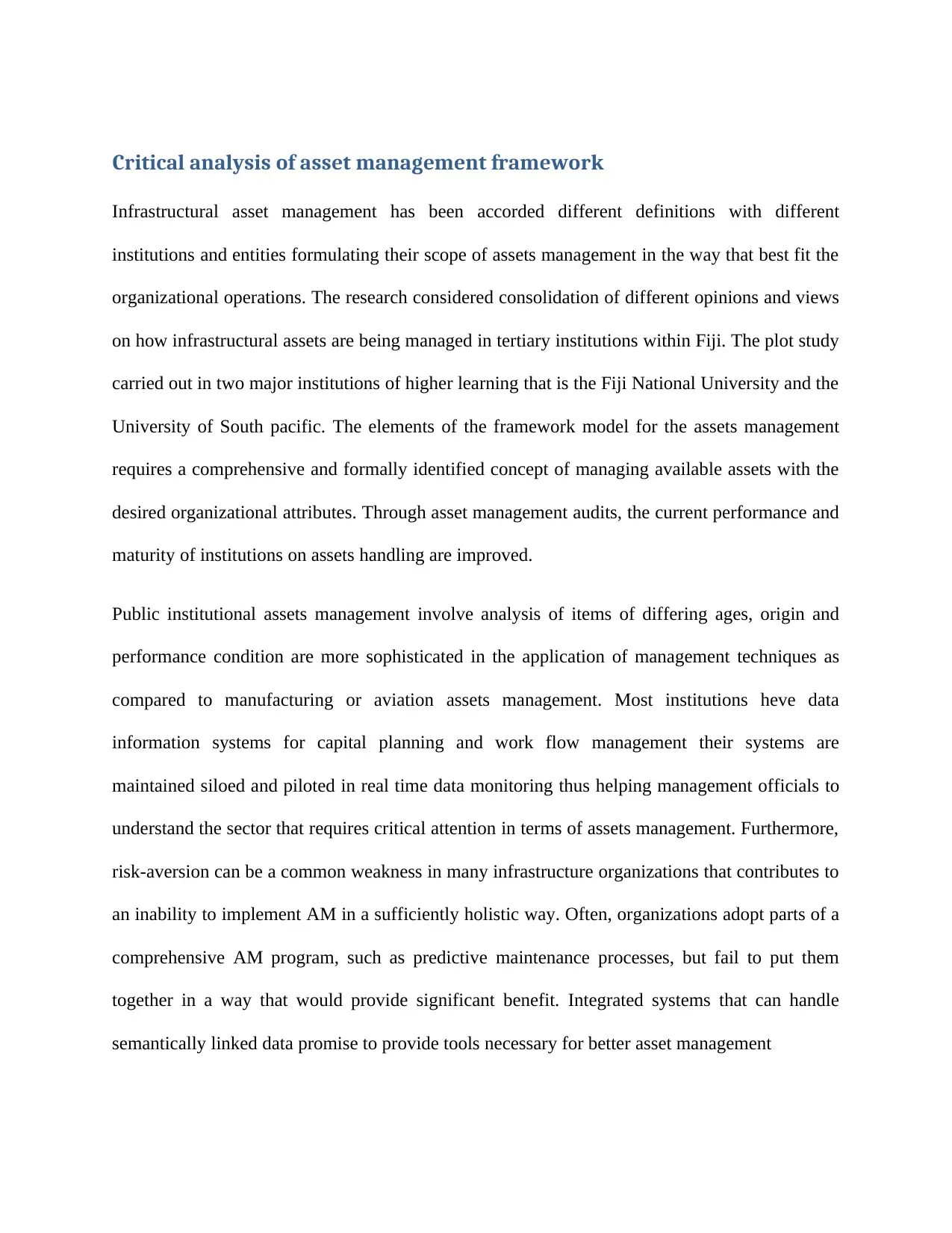
Critical analysis of asset management framework
Infrastructural asset management has been accorded different definitions with different
institutions and entities formulating their scope of assets management in the way that best fit the
organizational operations. The research considered consolidation of different opinions and views
on how infrastructural assets are being managed in tertiary institutions within Fiji. The plot study
carried out in two major institutions of higher learning that is the Fiji National University and the
University of South pacific. The elements of the framework model for the assets management
requires a comprehensive and formally identified concept of managing available assets with the
desired organizational attributes. Through asset management audits, the current performance and
maturity of institutions on assets handling are improved.
Public institutional assets management involve analysis of items of differing ages, origin and
performance condition are more sophisticated in the application of management techniques as
compared to manufacturing or aviation assets management. Most institutions heve data
information systems for capital planning and work flow management their systems are
maintained siloed and piloted in real time data monitoring thus helping management officials to
understand the sector that requires critical attention in terms of assets management. Furthermore,
risk-aversion can be a common weakness in many infrastructure organizations that contributes to
an inability to implement AM in a sufficiently holistic way. Often, organizations adopt parts of a
comprehensive AM program, such as predictive maintenance processes, but fail to put them
together in a way that would provide significant benefit. Integrated systems that can handle
semantically linked data promise to provide tools necessary for better asset management
Infrastructural asset management has been accorded different definitions with different
institutions and entities formulating their scope of assets management in the way that best fit the
organizational operations. The research considered consolidation of different opinions and views
on how infrastructural assets are being managed in tertiary institutions within Fiji. The plot study
carried out in two major institutions of higher learning that is the Fiji National University and the
University of South pacific. The elements of the framework model for the assets management
requires a comprehensive and formally identified concept of managing available assets with the
desired organizational attributes. Through asset management audits, the current performance and
maturity of institutions on assets handling are improved.
Public institutional assets management involve analysis of items of differing ages, origin and
performance condition are more sophisticated in the application of management techniques as
compared to manufacturing or aviation assets management. Most institutions heve data
information systems for capital planning and work flow management their systems are
maintained siloed and piloted in real time data monitoring thus helping management officials to
understand the sector that requires critical attention in terms of assets management. Furthermore,
risk-aversion can be a common weakness in many infrastructure organizations that contributes to
an inability to implement AM in a sufficiently holistic way. Often, organizations adopt parts of a
comprehensive AM program, such as predictive maintenance processes, but fail to put them
together in a way that would provide significant benefit. Integrated systems that can handle
semantically linked data promise to provide tools necessary for better asset management
Paraphrase This Document
Need a fresh take? Get an instant paraphrase of this document with our AI Paraphraser
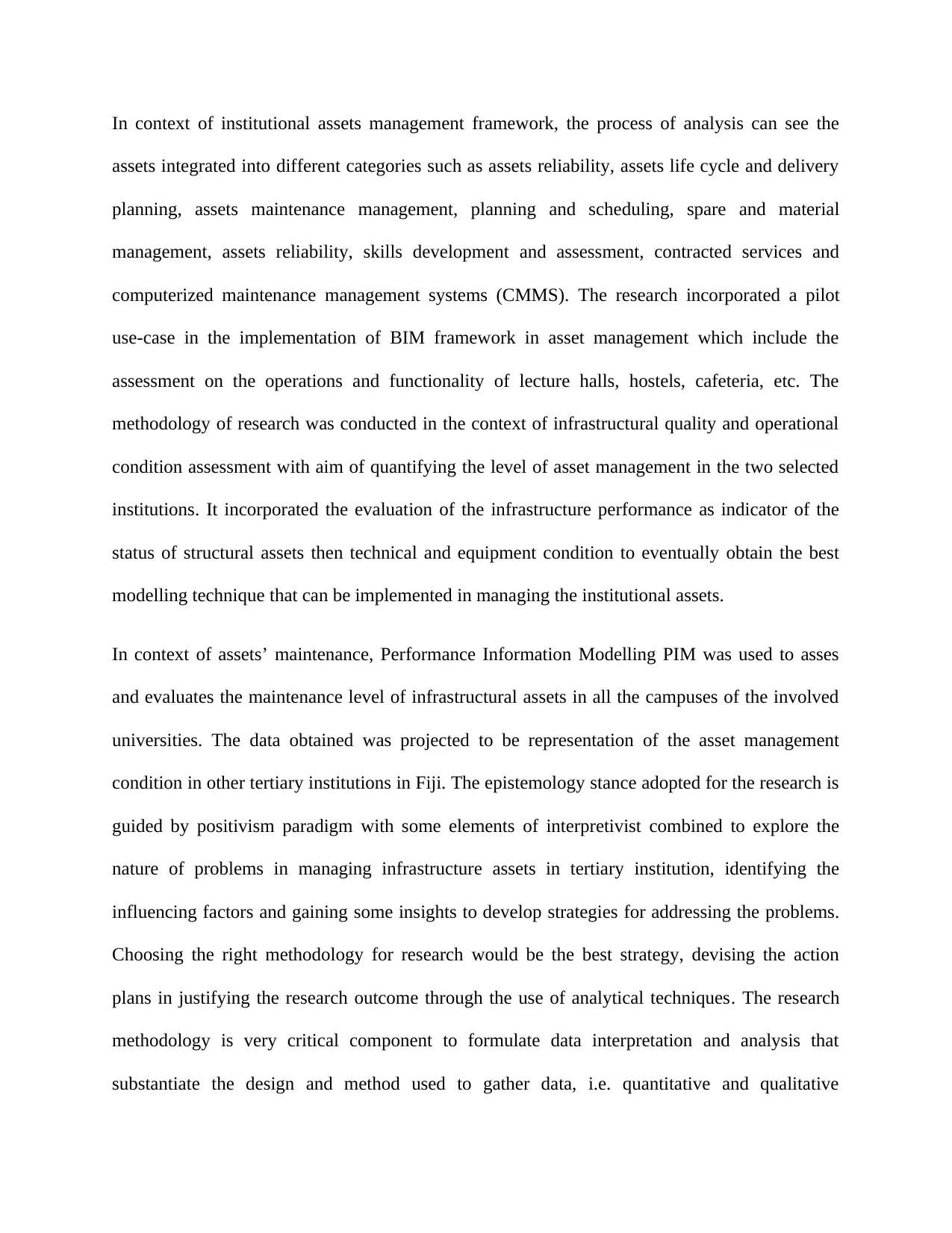
In context of institutional assets management framework, the process of analysis can see the
assets integrated into different categories such as assets reliability, assets life cycle and delivery
planning, assets maintenance management, planning and scheduling, spare and material
management, assets reliability, skills development and assessment, contracted services and
computerized maintenance management systems (CMMS). The research incorporated a pilot
use-case in the implementation of BIM framework in asset management which include the
assessment on the operations and functionality of lecture halls, hostels, cafeteria, etc. The
methodology of research was conducted in the context of infrastructural quality and operational
condition assessment with aim of quantifying the level of asset management in the two selected
institutions. It incorporated the evaluation of the infrastructure performance as indicator of the
status of structural assets then technical and equipment condition to eventually obtain the best
modelling technique that can be implemented in managing the institutional assets.
In context of assets’ maintenance, Performance Information Modelling PIM was used to asses
and evaluates the maintenance level of infrastructural assets in all the campuses of the involved
universities. The data obtained was projected to be representation of the asset management
condition in other tertiary institutions in Fiji. The epistemology stance adopted for the research is
guided by positivism paradigm with some elements of interpretivist combined to explore the
nature of problems in managing infrastructure assets in tertiary institution, identifying the
influencing factors and gaining some insights to develop strategies for addressing the problems.
Choosing the right methodology for research would be the best strategy, devising the action
plans in justifying the research outcome through the use of analytical techniques. The research
methodology is very critical component to formulate data interpretation and analysis that
substantiate the design and method used to gather data, i.e. quantitative and qualitative
assets integrated into different categories such as assets reliability, assets life cycle and delivery
planning, assets maintenance management, planning and scheduling, spare and material
management, assets reliability, skills development and assessment, contracted services and
computerized maintenance management systems (CMMS). The research incorporated a pilot
use-case in the implementation of BIM framework in asset management which include the
assessment on the operations and functionality of lecture halls, hostels, cafeteria, etc. The
methodology of research was conducted in the context of infrastructural quality and operational
condition assessment with aim of quantifying the level of asset management in the two selected
institutions. It incorporated the evaluation of the infrastructure performance as indicator of the
status of structural assets then technical and equipment condition to eventually obtain the best
modelling technique that can be implemented in managing the institutional assets.
In context of assets’ maintenance, Performance Information Modelling PIM was used to asses
and evaluates the maintenance level of infrastructural assets in all the campuses of the involved
universities. The data obtained was projected to be representation of the asset management
condition in other tertiary institutions in Fiji. The epistemology stance adopted for the research is
guided by positivism paradigm with some elements of interpretivist combined to explore the
nature of problems in managing infrastructure assets in tertiary institution, identifying the
influencing factors and gaining some insights to develop strategies for addressing the problems.
Choosing the right methodology for research would be the best strategy, devising the action
plans in justifying the research outcome through the use of analytical techniques. The research
methodology is very critical component to formulate data interpretation and analysis that
substantiate the design and method used to gather data, i.e. quantitative and qualitative
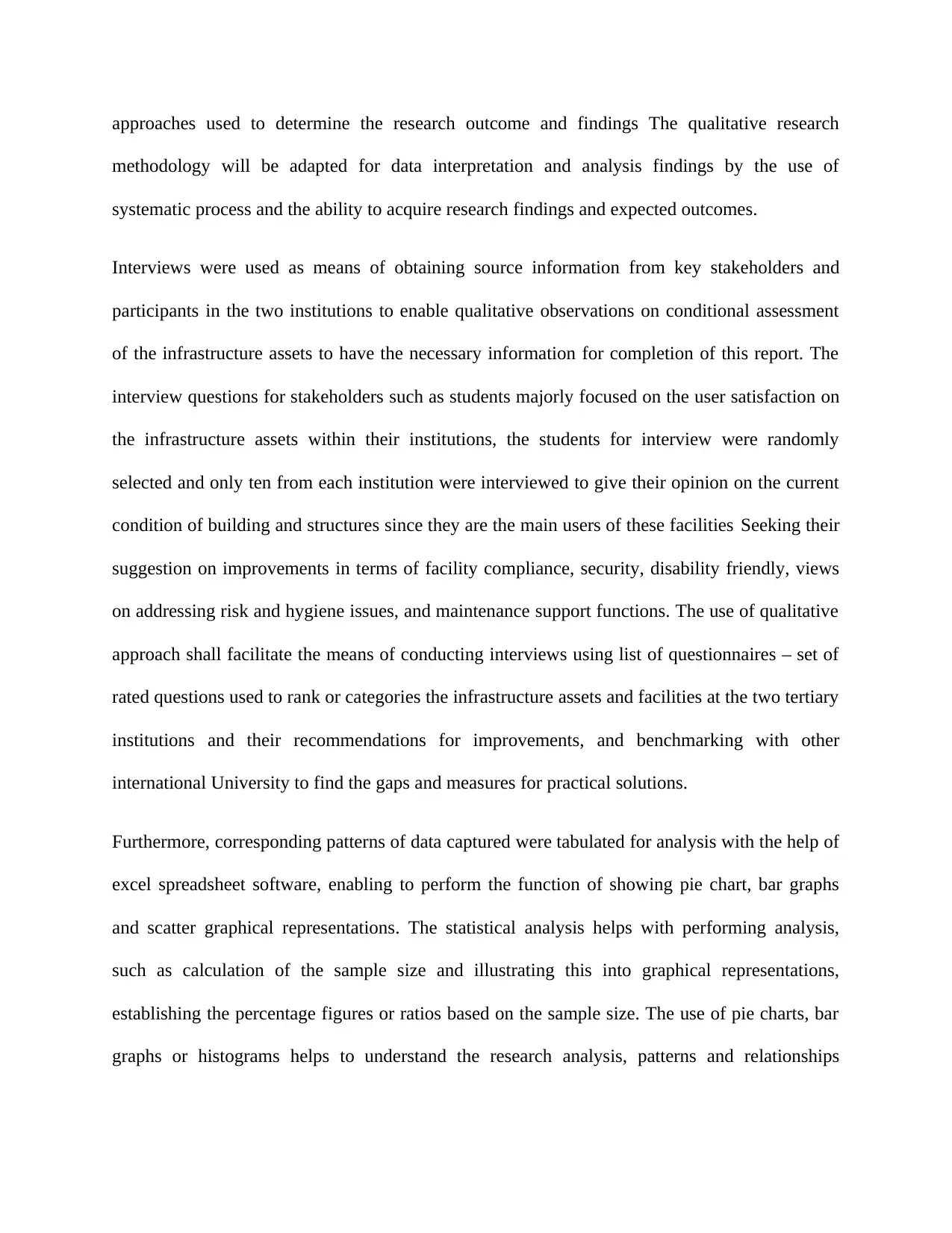
approaches used to determine the research outcome and findings The qualitative research
methodology will be adapted for data interpretation and analysis findings by the use of
systematic process and the ability to acquire research findings and expected outcomes.
Interviews were used as means of obtaining source information from key stakeholders and
participants in the two institutions to enable qualitative observations on conditional assessment
of the infrastructure assets to have the necessary information for completion of this report. The
interview questions for stakeholders such as students majorly focused on the user satisfaction on
the infrastructure assets within their institutions, the students for interview were randomly
selected and only ten from each institution were interviewed to give their opinion on the current
condition of building and structures since they are the main users of these facilities Seeking their
suggestion on improvements in terms of facility compliance, security, disability friendly, views
on addressing risk and hygiene issues, and maintenance support functions. The use of qualitative
approach shall facilitate the means of conducting interviews using list of questionnaires – set of
rated questions used to rank or categories the infrastructure assets and facilities at the two tertiary
institutions and their recommendations for improvements, and benchmarking with other
international University to find the gaps and measures for practical solutions.
Furthermore, corresponding patterns of data captured were tabulated for analysis with the help of
excel spreadsheet software, enabling to perform the function of showing pie chart, bar graphs
and scatter graphical representations. The statistical analysis helps with performing analysis,
such as calculation of the sample size and illustrating this into graphical representations,
establishing the percentage figures or ratios based on the sample size. The use of pie charts, bar
graphs or histograms helps to understand the research analysis, patterns and relationships
methodology will be adapted for data interpretation and analysis findings by the use of
systematic process and the ability to acquire research findings and expected outcomes.
Interviews were used as means of obtaining source information from key stakeholders and
participants in the two institutions to enable qualitative observations on conditional assessment
of the infrastructure assets to have the necessary information for completion of this report. The
interview questions for stakeholders such as students majorly focused on the user satisfaction on
the infrastructure assets within their institutions, the students for interview were randomly
selected and only ten from each institution were interviewed to give their opinion on the current
condition of building and structures since they are the main users of these facilities Seeking their
suggestion on improvements in terms of facility compliance, security, disability friendly, views
on addressing risk and hygiene issues, and maintenance support functions. The use of qualitative
approach shall facilitate the means of conducting interviews using list of questionnaires – set of
rated questions used to rank or categories the infrastructure assets and facilities at the two tertiary
institutions and their recommendations for improvements, and benchmarking with other
international University to find the gaps and measures for practical solutions.
Furthermore, corresponding patterns of data captured were tabulated for analysis with the help of
excel spreadsheet software, enabling to perform the function of showing pie chart, bar graphs
and scatter graphical representations. The statistical analysis helps with performing analysis,
such as calculation of the sample size and illustrating this into graphical representations,
establishing the percentage figures or ratios based on the sample size. The use of pie charts, bar
graphs or histograms helps to understand the research analysis, patterns and relationships
⊘ This is a preview!⊘
Do you want full access?
Subscribe today to unlock all pages.

Trusted by 1+ million students worldwide
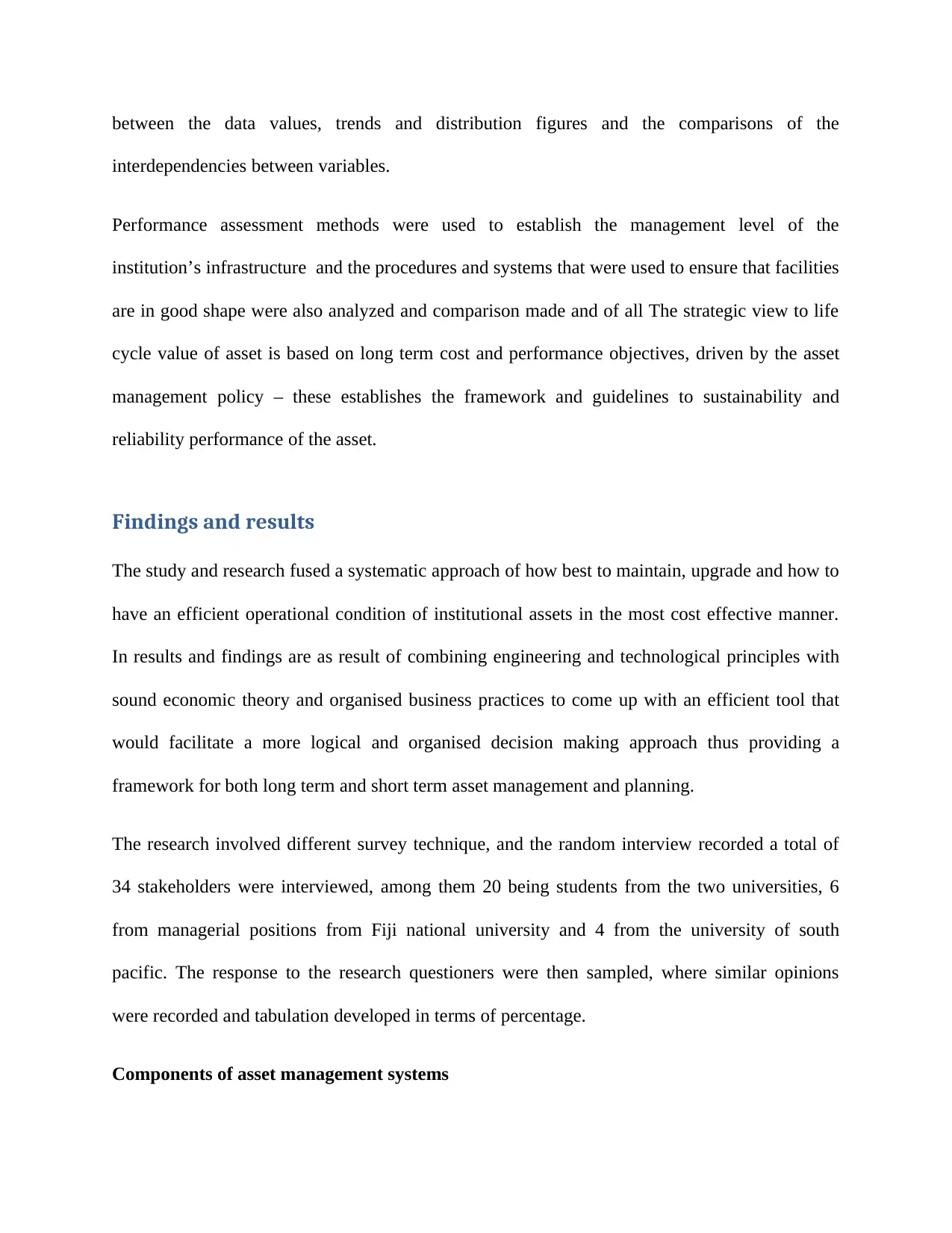
between the data values, trends and distribution figures and the comparisons of the
interdependencies between variables.
Performance assessment methods were used to establish the management level of the
institution’s infrastructure and the procedures and systems that were used to ensure that facilities
are in good shape were also analyzed and comparison made and of all The strategic view to life
cycle value of asset is based on long term cost and performance objectives, driven by the asset
management policy – these establishes the framework and guidelines to sustainability and
reliability performance of the asset.
Findings and results
The study and research fused a systematic approach of how best to maintain, upgrade and how to
have an efficient operational condition of institutional assets in the most cost effective manner.
In results and findings are as result of combining engineering and technological principles with
sound economic theory and organised business practices to come up with an efficient tool that
would facilitate a more logical and organised decision making approach thus providing a
framework for both long term and short term asset management and planning.
The research involved different survey technique, and the random interview recorded a total of
34 stakeholders were interviewed, among them 20 being students from the two universities, 6
from managerial positions from Fiji national university and 4 from the university of south
pacific. The response to the research questioners were then sampled, where similar opinions
were recorded and tabulation developed in terms of percentage.
Components of asset management systems
interdependencies between variables.
Performance assessment methods were used to establish the management level of the
institution’s infrastructure and the procedures and systems that were used to ensure that facilities
are in good shape were also analyzed and comparison made and of all The strategic view to life
cycle value of asset is based on long term cost and performance objectives, driven by the asset
management policy – these establishes the framework and guidelines to sustainability and
reliability performance of the asset.
Findings and results
The study and research fused a systematic approach of how best to maintain, upgrade and how to
have an efficient operational condition of institutional assets in the most cost effective manner.
In results and findings are as result of combining engineering and technological principles with
sound economic theory and organised business practices to come up with an efficient tool that
would facilitate a more logical and organised decision making approach thus providing a
framework for both long term and short term asset management and planning.
The research involved different survey technique, and the random interview recorded a total of
34 stakeholders were interviewed, among them 20 being students from the two universities, 6
from managerial positions from Fiji national university and 4 from the university of south
pacific. The response to the research questioners were then sampled, where similar opinions
were recorded and tabulation developed in terms of percentage.
Components of asset management systems
Paraphrase This Document
Need a fresh take? Get an instant paraphrase of this document with our AI Paraphraser
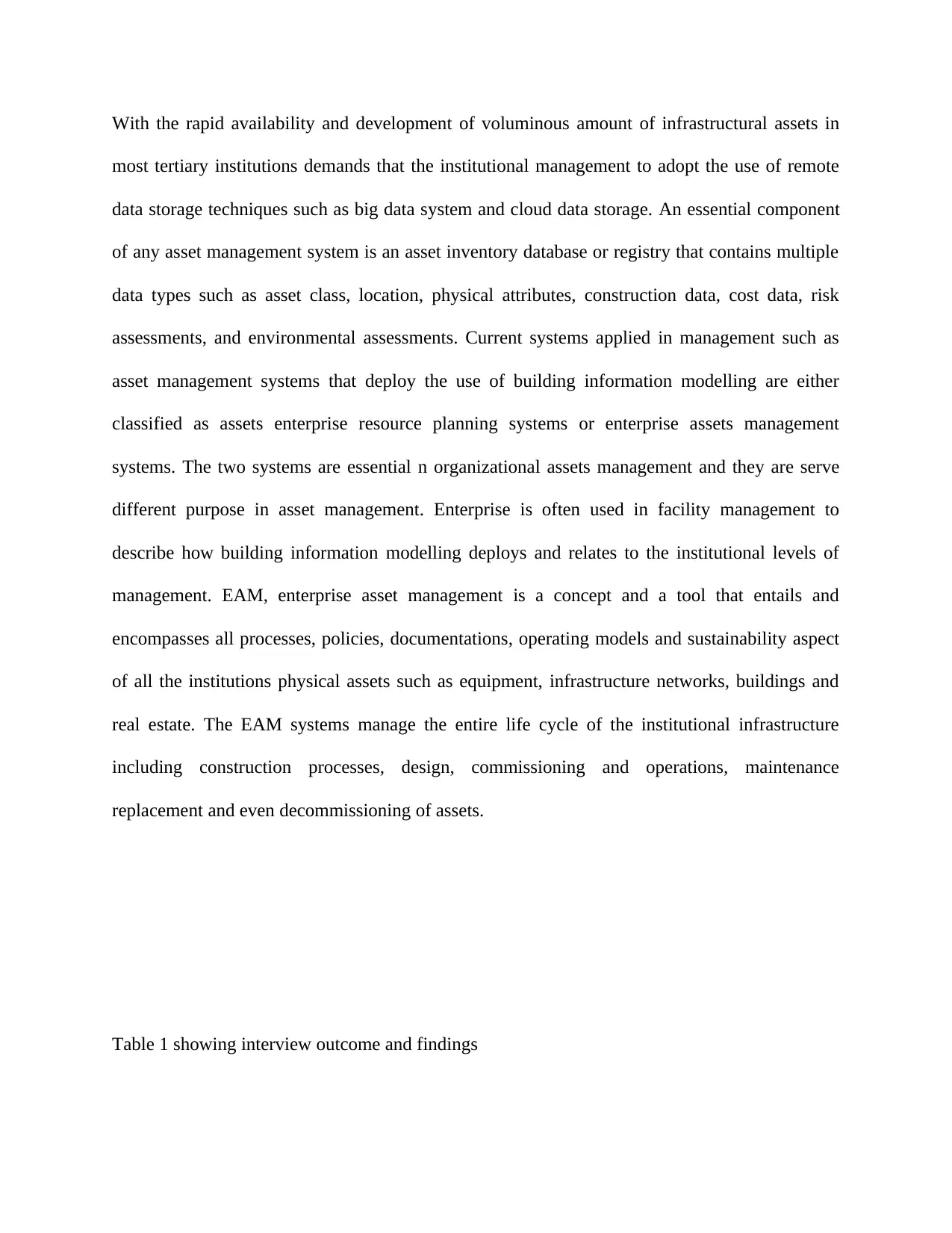
With the rapid availability and development of voluminous amount of infrastructural assets in
most tertiary institutions demands that the institutional management to adopt the use of remote
data storage techniques such as big data system and cloud data storage. An essential component
of any asset management system is an asset inventory database or registry that contains multiple
data types such as asset class, location, physical attributes, construction data, cost data, risk
assessments, and environmental assessments. Current systems applied in management such as
asset management systems that deploy the use of building information modelling are either
classified as assets enterprise resource planning systems or enterprise assets management
systems. The two systems are essential n organizational assets management and they are serve
different purpose in asset management. Enterprise is often used in facility management to
describe how building information modelling deploys and relates to the institutional levels of
management. EAM, enterprise asset management is a concept and a tool that entails and
encompasses all processes, policies, documentations, operating models and sustainability aspect
of all the institutions physical assets such as equipment, infrastructure networks, buildings and
real estate. The EAM systems manage the entire life cycle of the institutional infrastructure
including construction processes, design, commissioning and operations, maintenance
replacement and even decommissioning of assets.
Table 1 showing interview outcome and findings
most tertiary institutions demands that the institutional management to adopt the use of remote
data storage techniques such as big data system and cloud data storage. An essential component
of any asset management system is an asset inventory database or registry that contains multiple
data types such as asset class, location, physical attributes, construction data, cost data, risk
assessments, and environmental assessments. Current systems applied in management such as
asset management systems that deploy the use of building information modelling are either
classified as assets enterprise resource planning systems or enterprise assets management
systems. The two systems are essential n organizational assets management and they are serve
different purpose in asset management. Enterprise is often used in facility management to
describe how building information modelling deploys and relates to the institutional levels of
management. EAM, enterprise asset management is a concept and a tool that entails and
encompasses all processes, policies, documentations, operating models and sustainability aspect
of all the institutions physical assets such as equipment, infrastructure networks, buildings and
real estate. The EAM systems manage the entire life cycle of the institutional infrastructure
including construction processes, design, commissioning and operations, maintenance
replacement and even decommissioning of assets.
Table 1 showing interview outcome and findings
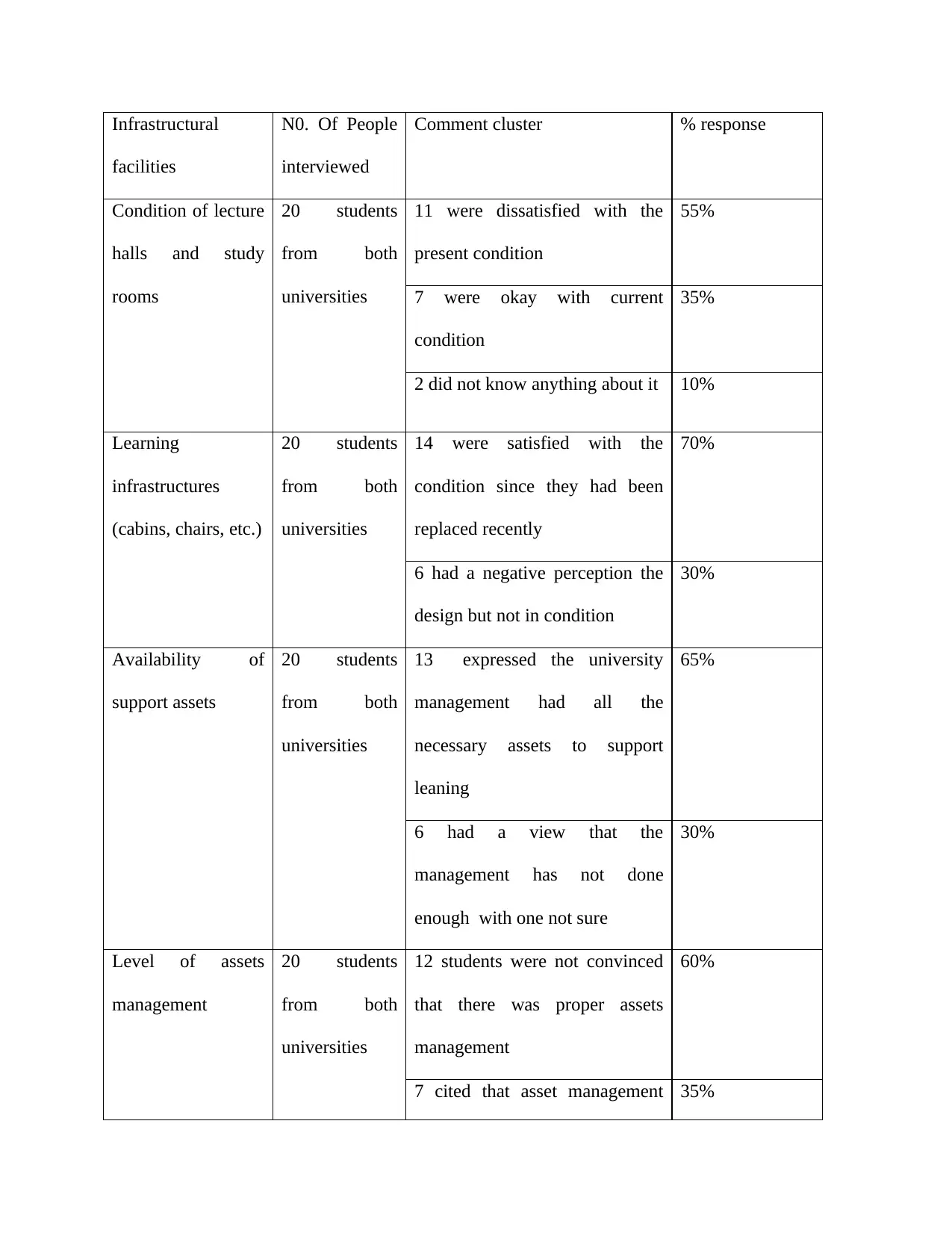
Infrastructural
facilities
N0. Of People
interviewed
Comment cluster % response
Condition of lecture
halls and study
rooms
20 students
from both
universities
11 were dissatisfied with the
present condition
55%
7 were okay with current
condition
35%
2 did not know anything about it 10%
Learning
infrastructures
(cabins, chairs, etc.)
20 students
from both
universities
14 were satisfied with the
condition since they had been
replaced recently
70%
6 had a negative perception the
design but not in condition
30%
Availability of
support assets
20 students
from both
universities
13 expressed the university
management had all the
necessary assets to support
leaning
65%
6 had a view that the
management has not done
enough with one not sure
30%
Level of assets
management
20 students
from both
universities
12 students were not convinced
that there was proper assets
management
60%
7 cited that asset management 35%
facilities
N0. Of People
interviewed
Comment cluster % response
Condition of lecture
halls and study
rooms
20 students
from both
universities
11 were dissatisfied with the
present condition
55%
7 were okay with current
condition
35%
2 did not know anything about it 10%
Learning
infrastructures
(cabins, chairs, etc.)
20 students
from both
universities
14 were satisfied with the
condition since they had been
replaced recently
70%
6 had a negative perception the
design but not in condition
30%
Availability of
support assets
20 students
from both
universities
13 expressed the university
management had all the
necessary assets to support
leaning
65%
6 had a view that the
management has not done
enough with one not sure
30%
Level of assets
management
20 students
from both
universities
12 students were not convinced
that there was proper assets
management
60%
7 cited that asset management 35%
⊘ This is a preview!⊘
Do you want full access?
Subscribe today to unlock all pages.

Trusted by 1+ million students worldwide
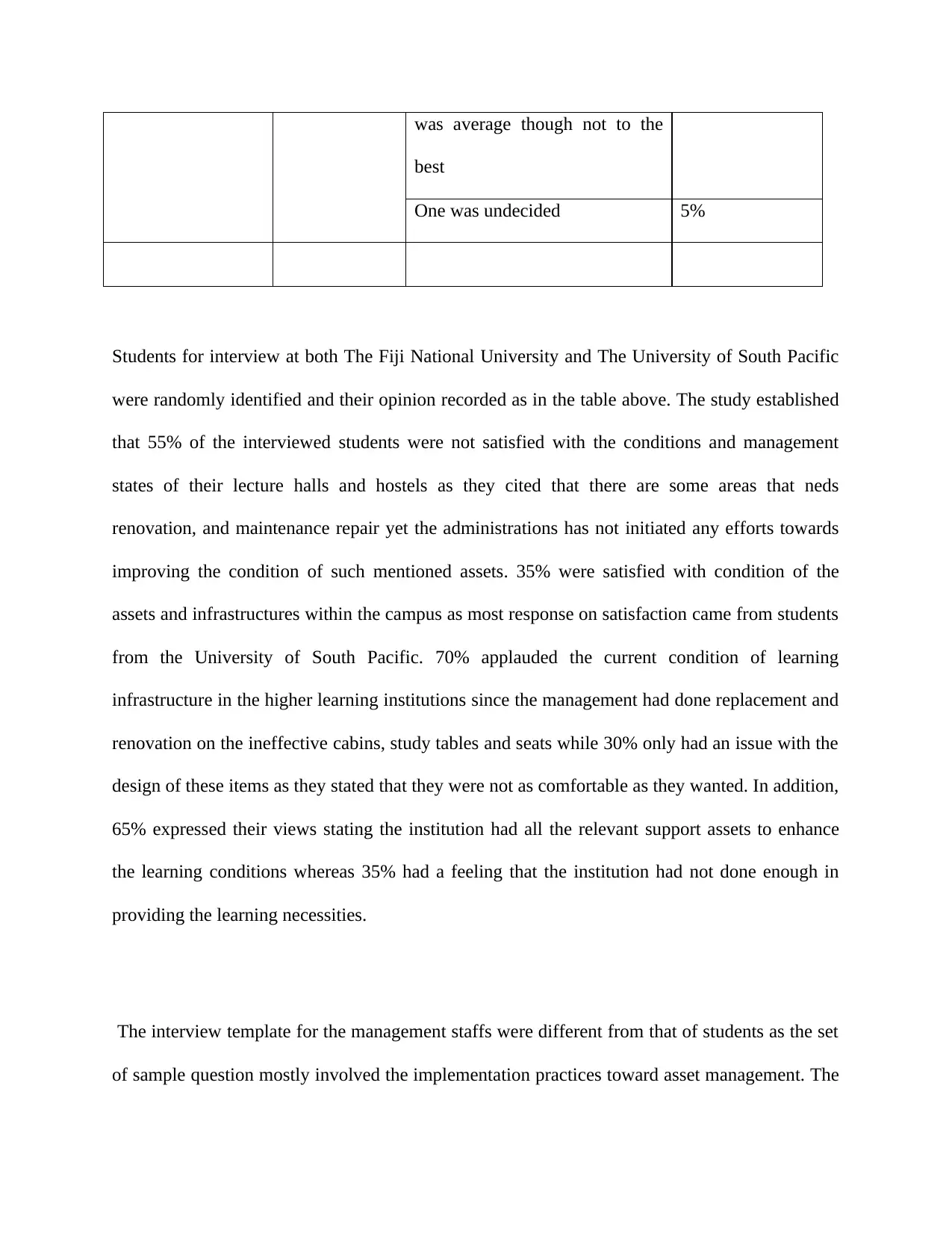
was average though not to the
best
One was undecided 5%
Students for interview at both The Fiji National University and The University of South Pacific
were randomly identified and their opinion recorded as in the table above. The study established
that 55% of the interviewed students were not satisfied with the conditions and management
states of their lecture halls and hostels as they cited that there are some areas that neds
renovation, and maintenance repair yet the administrations has not initiated any efforts towards
improving the condition of such mentioned assets. 35% were satisfied with condition of the
assets and infrastructures within the campus as most response on satisfaction came from students
from the University of South Pacific. 70% applauded the current condition of learning
infrastructure in the higher learning institutions since the management had done replacement and
renovation on the ineffective cabins, study tables and seats while 30% only had an issue with the
design of these items as they stated that they were not as comfortable as they wanted. In addition,
65% expressed their views stating the institution had all the relevant support assets to enhance
the learning conditions whereas 35% had a feeling that the institution had not done enough in
providing the learning necessities.
The interview template for the management staffs were different from that of students as the set
of sample question mostly involved the implementation practices toward asset management. The
best
One was undecided 5%
Students for interview at both The Fiji National University and The University of South Pacific
were randomly identified and their opinion recorded as in the table above. The study established
that 55% of the interviewed students were not satisfied with the conditions and management
states of their lecture halls and hostels as they cited that there are some areas that neds
renovation, and maintenance repair yet the administrations has not initiated any efforts towards
improving the condition of such mentioned assets. 35% were satisfied with condition of the
assets and infrastructures within the campus as most response on satisfaction came from students
from the University of South Pacific. 70% applauded the current condition of learning
infrastructure in the higher learning institutions since the management had done replacement and
renovation on the ineffective cabins, study tables and seats while 30% only had an issue with the
design of these items as they stated that they were not as comfortable as they wanted. In addition,
65% expressed their views stating the institution had all the relevant support assets to enhance
the learning conditions whereas 35% had a feeling that the institution had not done enough in
providing the learning necessities.
The interview template for the management staffs were different from that of students as the set
of sample question mostly involved the implementation practices toward asset management. The
Paraphrase This Document
Need a fresh take? Get an instant paraphrase of this document with our AI Paraphraser
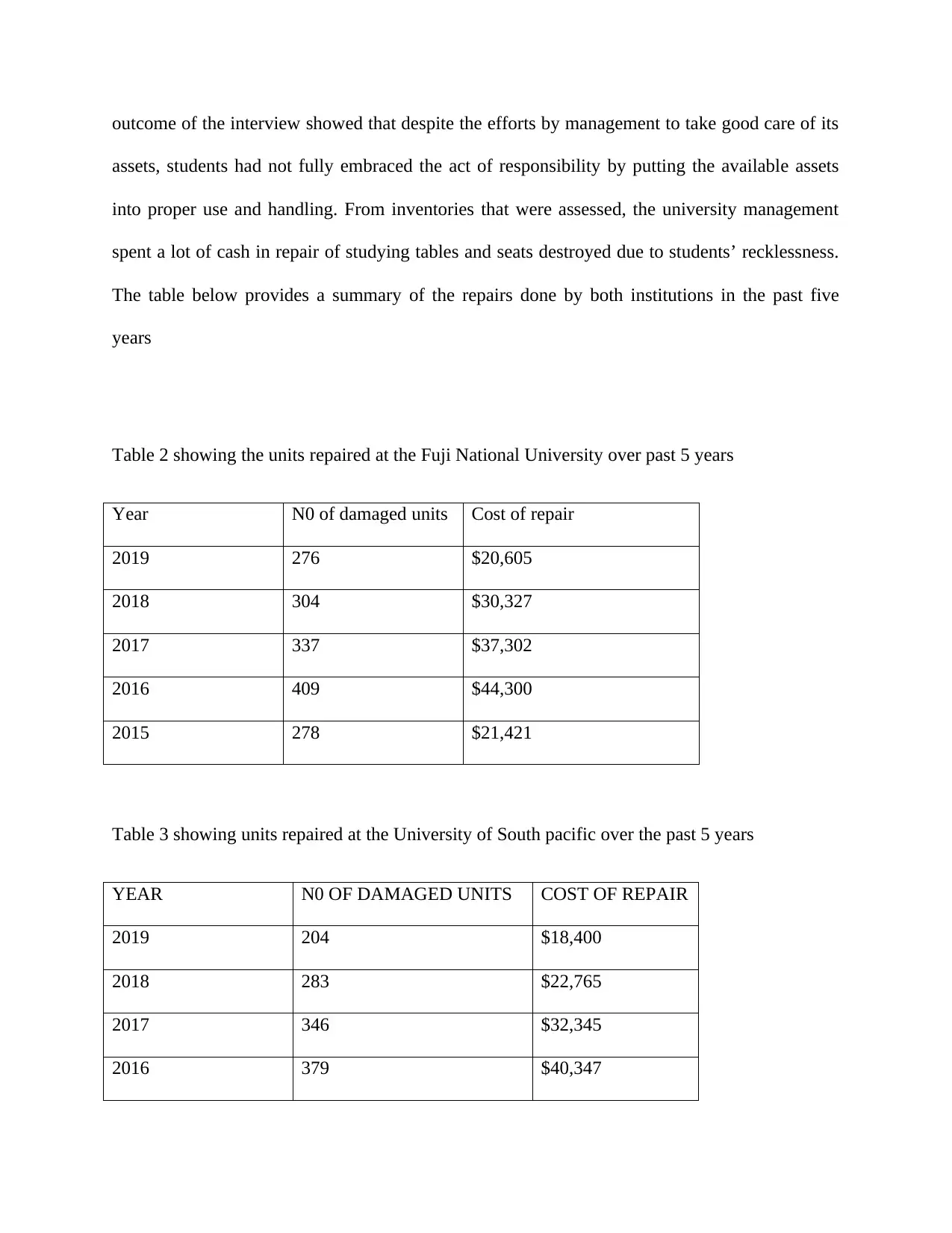
outcome of the interview showed that despite the efforts by management to take good care of its
assets, students had not fully embraced the act of responsibility by putting the available assets
into proper use and handling. From inventories that were assessed, the university management
spent a lot of cash in repair of studying tables and seats destroyed due to students’ recklessness.
The table below provides a summary of the repairs done by both institutions in the past five
years
Table 2 showing the units repaired at the Fuji National University over past 5 years
Year N0 of damaged units Cost of repair
2019 276 $20,605
2018 304 $30,327
2017 337 $37,302
2016 409 $44,300
2015 278 $21,421
Table 3 showing units repaired at the University of South pacific over the past 5 years
YEAR N0 OF DAMAGED UNITS COST OF REPAIR
2019 204 $18,400
2018 283 $22,765
2017 346 $32,345
2016 379 $40,347
assets, students had not fully embraced the act of responsibility by putting the available assets
into proper use and handling. From inventories that were assessed, the university management
spent a lot of cash in repair of studying tables and seats destroyed due to students’ recklessness.
The table below provides a summary of the repairs done by both institutions in the past five
years
Table 2 showing the units repaired at the Fuji National University over past 5 years
Year N0 of damaged units Cost of repair
2019 276 $20,605
2018 304 $30,327
2017 337 $37,302
2016 409 $44,300
2015 278 $21,421
Table 3 showing units repaired at the University of South pacific over the past 5 years
YEAR N0 OF DAMAGED UNITS COST OF REPAIR
2019 204 $18,400
2018 283 $22,765
2017 346 $32,345
2016 379 $40,347
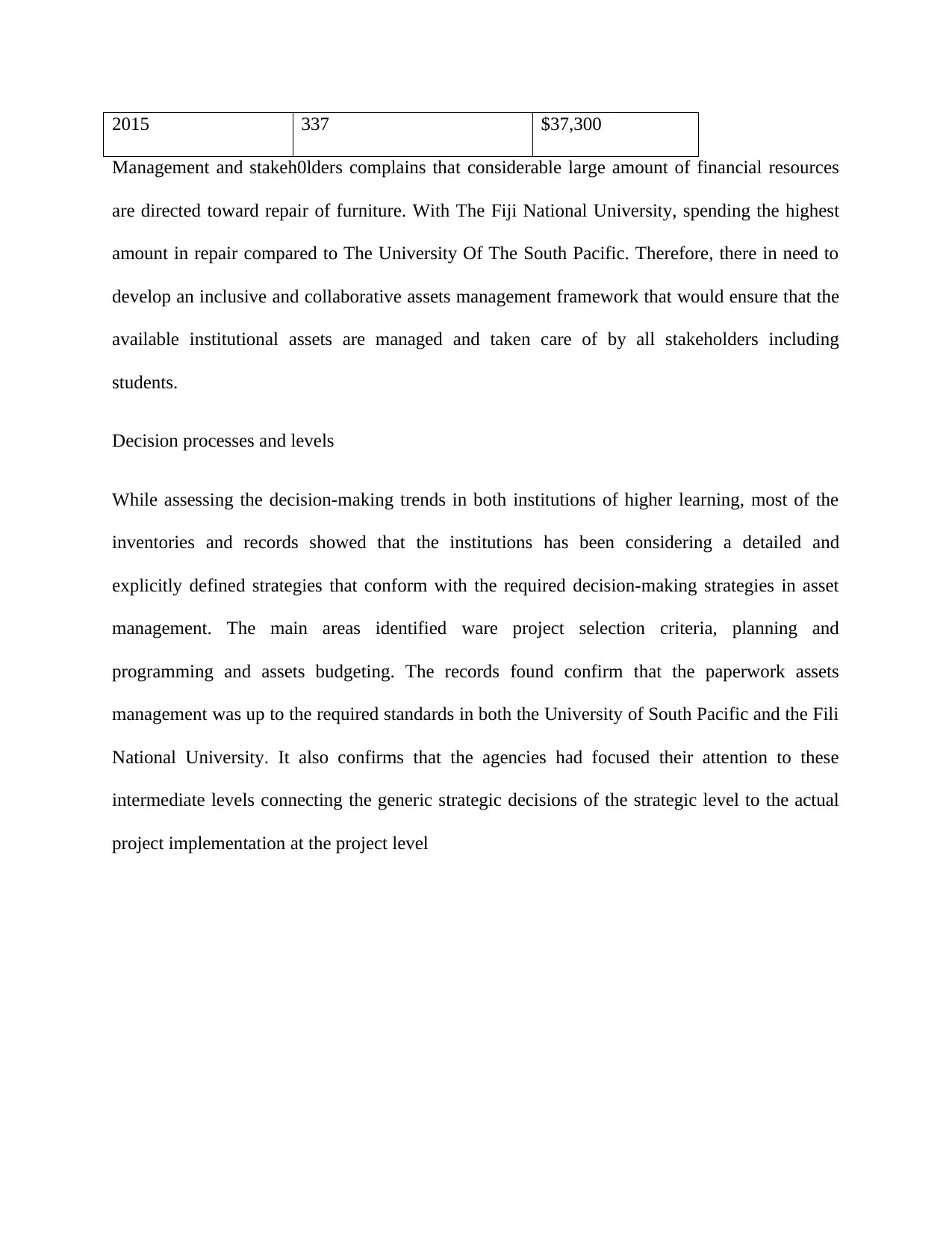
2015 337 $37,300
Management and stakeh0lders complains that considerable large amount of financial resources
are directed toward repair of furniture. With The Fiji National University, spending the highest
amount in repair compared to The University Of The South Pacific. Therefore, there in need to
develop an inclusive and collaborative assets management framework that would ensure that the
available institutional assets are managed and taken care of by all stakeholders including
students.
Decision processes and levels
While assessing the decision-making trends in both institutions of higher learning, most of the
inventories and records showed that the institutions has been considering a detailed and
explicitly defined strategies that conform with the required decision-making strategies in asset
management. The main areas identified ware project selection criteria, planning and
programming and assets budgeting. The records found confirm that the paperwork assets
management was up to the required standards in both the University of South Pacific and the Fili
National University. It also confirms that the agencies had focused their attention to these
intermediate levels connecting the generic strategic decisions of the strategic level to the actual
project implementation at the project level
Management and stakeh0lders complains that considerable large amount of financial resources
are directed toward repair of furniture. With The Fiji National University, spending the highest
amount in repair compared to The University Of The South Pacific. Therefore, there in need to
develop an inclusive and collaborative assets management framework that would ensure that the
available institutional assets are managed and taken care of by all stakeholders including
students.
Decision processes and levels
While assessing the decision-making trends in both institutions of higher learning, most of the
inventories and records showed that the institutions has been considering a detailed and
explicitly defined strategies that conform with the required decision-making strategies in asset
management. The main areas identified ware project selection criteria, planning and
programming and assets budgeting. The records found confirm that the paperwork assets
management was up to the required standards in both the University of South Pacific and the Fili
National University. It also confirms that the agencies had focused their attention to these
intermediate levels connecting the generic strategic decisions of the strategic level to the actual
project implementation at the project level
⊘ This is a preview!⊘
Do you want full access?
Subscribe today to unlock all pages.

Trusted by 1+ million students worldwide
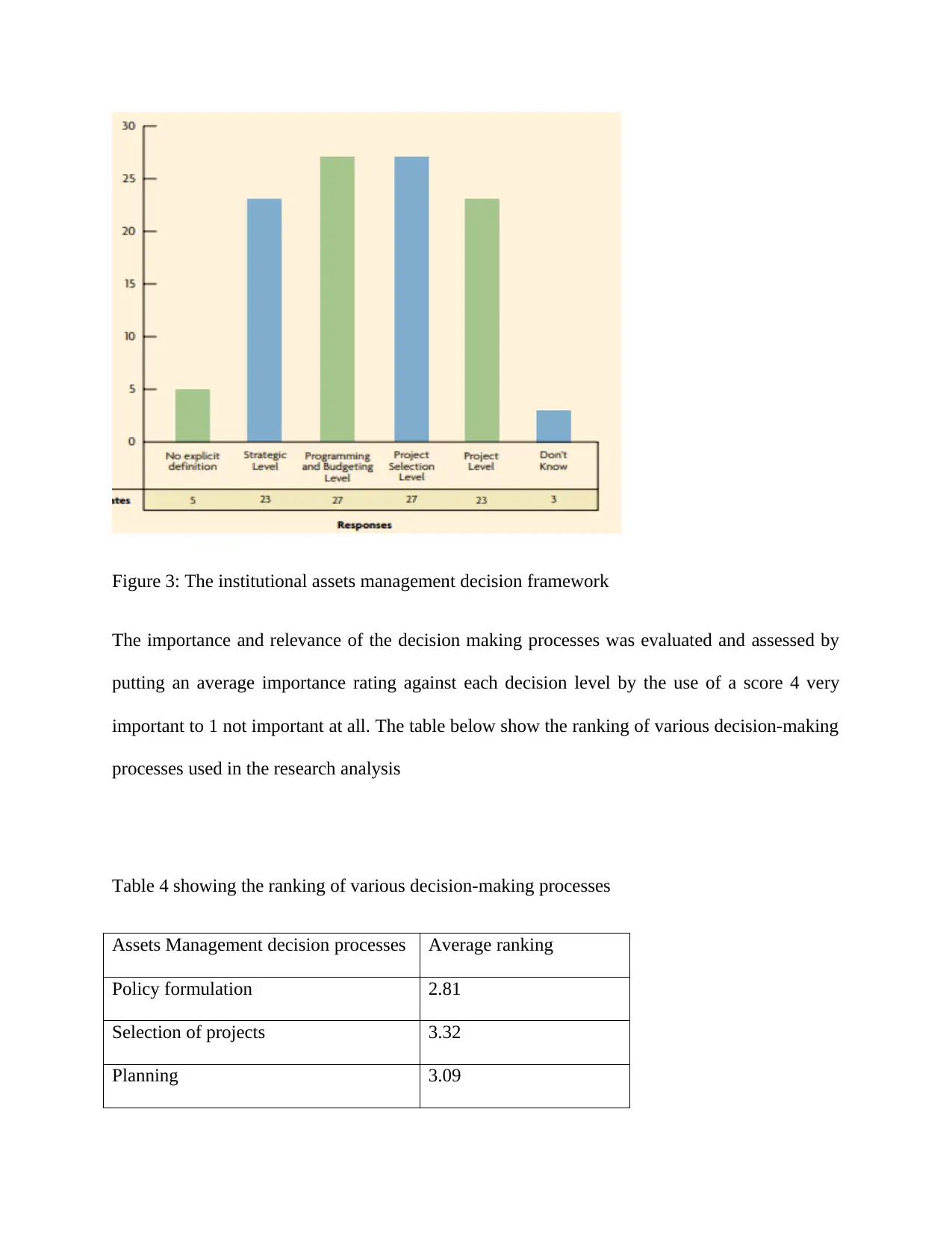
Figure 3: The institutional assets management decision framework
The importance and relevance of the decision making processes was evaluated and assessed by
putting an average importance rating against each decision level by the use of a score 4 very
important to 1 not important at all. The table below show the ranking of various decision-making
processes used in the research analysis
Table 4 showing the ranking of various decision-making processes
Assets Management decision processes Average ranking
Policy formulation 2.81
Selection of projects 3.32
Planning 3.09
The importance and relevance of the decision making processes was evaluated and assessed by
putting an average importance rating against each decision level by the use of a score 4 very
important to 1 not important at all. The table below show the ranking of various decision-making
processes used in the research analysis
Table 4 showing the ranking of various decision-making processes
Assets Management decision processes Average ranking
Policy formulation 2.81
Selection of projects 3.32
Planning 3.09
Paraphrase This Document
Need a fresh take? Get an instant paraphrase of this document with our AI Paraphraser
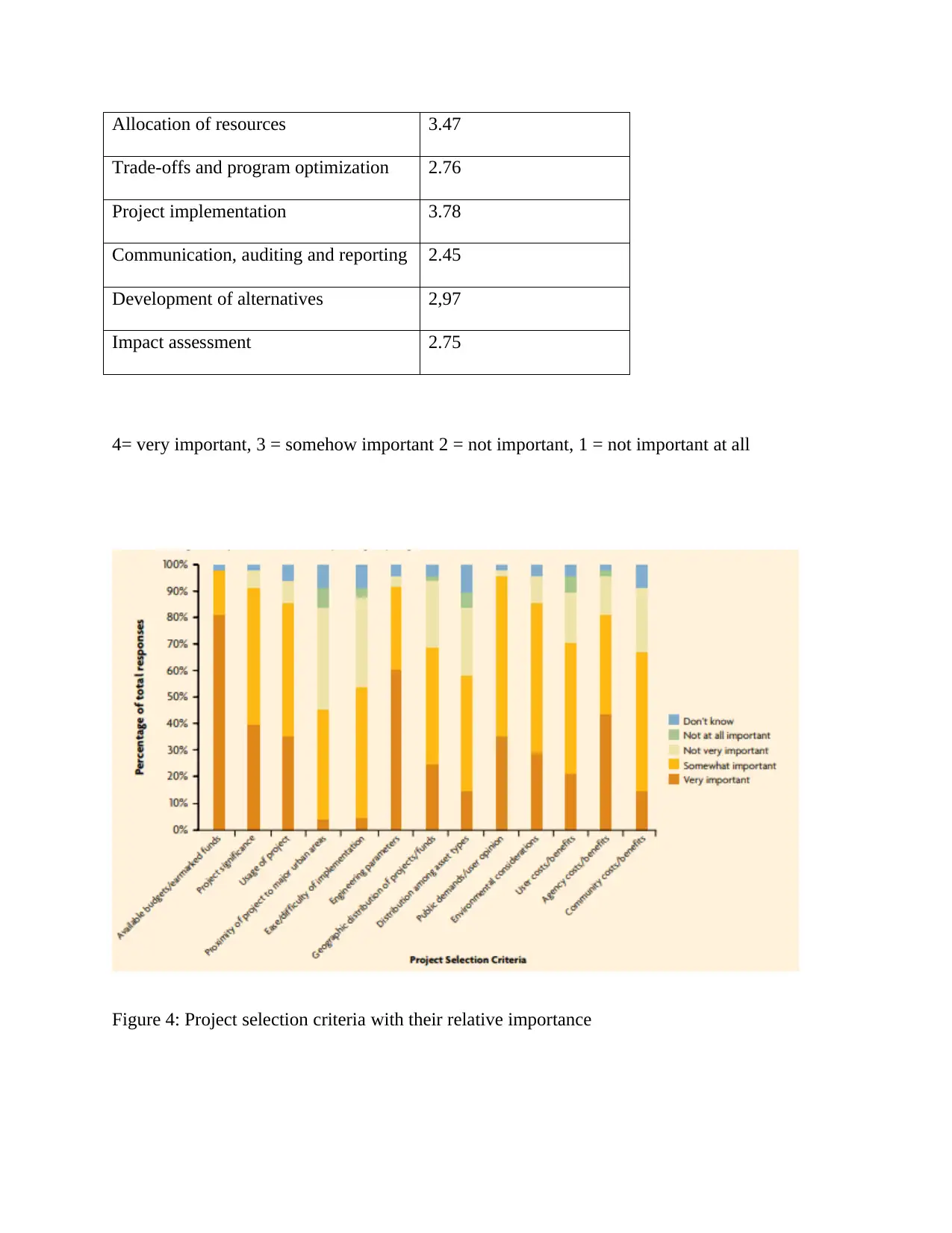
Allocation of resources 3.47
Trade-offs and program optimization 2.76
Project implementation 3.78
Communication, auditing and reporting 2.45
Development of alternatives 2,97
Impact assessment 2.75
4= very important, 3 = somehow important 2 = not important, 1 = not important at all
Figure 4: Project selection criteria with their relative importance
Trade-offs and program optimization 2.76
Project implementation 3.78
Communication, auditing and reporting 2.45
Development of alternatives 2,97
Impact assessment 2.75
4= very important, 3 = somehow important 2 = not important, 1 = not important at all
Figure 4: Project selection criteria with their relative importance

Discussion
⊘ This is a preview!⊘
Do you want full access?
Subscribe today to unlock all pages.

Trusted by 1+ million students worldwide
1 out of 12
Related Documents
Your All-in-One AI-Powered Toolkit for Academic Success.
+13062052269
info@desklib.com
Available 24*7 on WhatsApp / Email
![[object Object]](/_next/static/media/star-bottom.7253800d.svg)
Unlock your academic potential
Copyright © 2020–2025 A2Z Services. All Rights Reserved. Developed and managed by ZUCOL.




